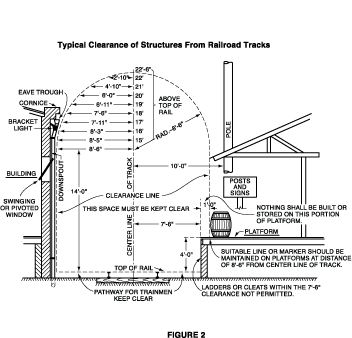I am designing my rail track plan and would like recommendations on the spacing distance between straight and curved runs of track. Also what is the recomended spacing between tracks in a rail yard. What number switch is the best to use for a yard ladder that would give the correct spacing on the rail lines. What is the recommended set back distance between structures such as rail stations, freight stations, etc. and the rail line. I am modeling narrow gauge in 1:20 scale. I will have both freight and passenger operations. All my engines will be steam with one small diesel shifter. My rail line time frame will be the early 1900’s. Is there a chart somewhere on the site that has this type of information?
Thanks for any help.
Big John


 Distance on curves depends on three major factors…the diameter of the curve, the length of your two longest cars and the swing of your largest locomotive. On tighter curves some cars and locomotives have some really serious overhang. The easiest way to figure that out is to make a mockup of the curves you want and run the two cars past each other. If they clear, then you are ok. As an example, if you are running a shay with short logging cars you could probably get by with 7" between centers on 8’ diameter track. If, on the other hand you are running Accucraft’s new passenger cars and a K27 you would need to plan on 12-15 foot diameter curves and around 9" center to center. In summing this up, the real answer is, if they don’t bang into each other you have it correct…
Distance on curves depends on three major factors…the diameter of the curve, the length of your two longest cars and the swing of your largest locomotive. On tighter curves some cars and locomotives have some really serious overhang. The easiest way to figure that out is to make a mockup of the curves you want and run the two cars past each other. If they clear, then you are ok. As an example, if you are running a shay with short logging cars you could probably get by with 7" between centers on 8’ diameter track. If, on the other hand you are running Accucraft’s new passenger cars and a K27 you would need to plan on 12-15 foot diameter curves and around 9" center to center. In summing this up, the real answer is, if they don’t bang into each other you have it correct…



